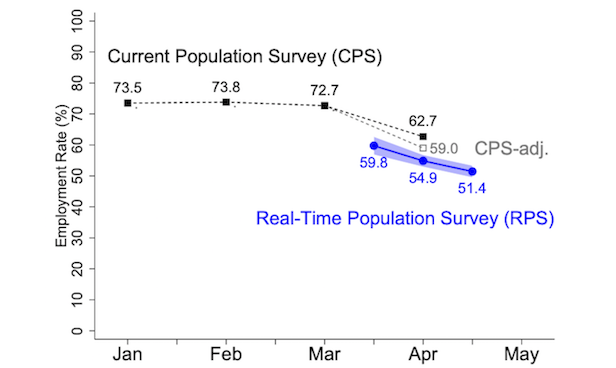
May 12, 2020
New survey shows decline in employment has slowed since mid-April
Share this story
U.S. employment continued to decline in late April, but at a noticeably slower pace than in previous weeks, according to a report by economists from Virginia Commonwealth University and Arizona State University.
“This suggests that we are past the worst period of job losses, at least for the time being,” said Adam Blandin, Ph.D., an assistant professor in the VCU School of Business who conducts the biweekly Real Time Population Survey with Alexander Bick, Ph.D., an associate professor of economics at Arizona State. “However, the damage that has been done is unprecedented. Our estimates imply that, at the end of April, roughly 1 in 4 people who were working in February are no longer working.”
These estimates reflect the week of April 26 through May 2. Conversely, the most recent labor market figures from the U.S. Bureau of Labor Statistics — which show unemployment rose to 14.7% — refer to April 12-18.
“It is already three weeks out of date,” Blandin said of the government report. “We will not have new government estimates until June 5. In the meantime, some states will begin to reopen their economy, while others will remain largely closed. The time lag of government data means that it will not be able to shed light on the effects of these policies for four crucial weeks. In contrast ... we will post results from our next survey in only two weeks.”

Blandin and Bick started the Real Time Population Survey out of a desire to use their skills as economists to help policymakers, reporters, analysts and the public during this pandemic. Since launch, their research has been cited widely in national publications such as The Wall Street Journal, Bloomberg, Business Insider, Forbes, The New York Times and The Washington Post, and has drawn attention from notable economists worldwide.
The Real Time Population Survey closely follows the methodology of the Department of Labor’s Current Population Survey. The current labor department report overlaps with Blandin and Bick's April 12-18 report released April 24, marking the first opportunity to compare data.
“Overall, we think this was a good outcome as a first test,” Blandin said.
Retrospective questions about employment, hours worked and earnings in February generate strikingly similar distributions when comparing the two surveys. However, relative to the change from February to April, the Real Time Population Survey found larger changes in work outcomes than the government numbers. Blandin and Bick have made improvements with each survey wave and plan to continue refining their methodology going forward.
Estimates from the first three waves of the survey suggest unprecedented changes in the U.S. labor market since mid-March. Among the key findings:
- In the week of April 26-May 2, the employment rate was 51.4% among working-age adults. While employment fell in the most recent wave, the decline has slowed noticeably.
- The unemployment rate rose since mid-April to 23.6% while the labor force participation rate remained fairly flat (though well below its level in March).
- Most of those who have recently lost their job believe they could return to it if the economy were to reopen quickly.
- Among those who were employed in February, 44% have experienced a loss in earnings.
Blandin and Bick will release the next wave of survey results on May 22, referencing the week of May 10-16. Subscribe to receive future results at https://sites.google.com/view/covid-rps/.
Subscribe to VCU News
Subscribe to VCU News at newsletter.vcu.edu and receive a selection of stories, videos, photos, news clips and event listings in your inbox.








